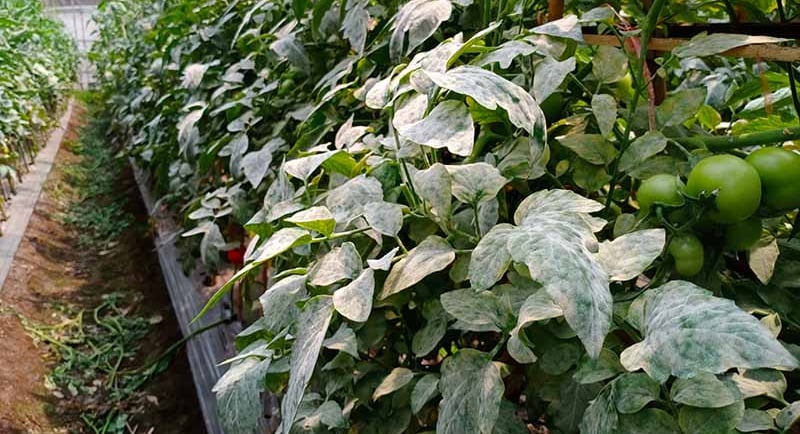Revolutionizing Plant Health: Controlling Powdery Mildew with AI-GENIX’s PathoShield
AI-GENIX’s PathoShield offers a safe, effective, and environmentally friendly approach to managing powdery mildew, contributing to healthier, pesticide-free crops and advancing sustainable agricultural practices.
Khalil Shaikh
5/25/20243 min read


Powdery Mildew
Powdery mildew is caused by a variety of fungal species, each typically associated with specific host plants. It is a common fungal disease that affects a wide range of plants, including vegetables, fruits, ornamental plants, and grains. It is characterized by the presence of white or greyish powdery spots on the leaves, stems, and sometimes flowers and fruits.
Symptoms:
White to grey powdery spots or patches on the upper surface of leaves.
Infected leaves may become distorted, curled, or turn yellow.
In severe cases, the entire leaf surface can be covered with powdery growth.
Stems, flowers, and fruits can also be affected, showing similar powdery growth.
Premature leaf drops and reduced photosynthesis, lead to stunted plant growth and lower yields.
Conditions Favouring Powdery Mildew:
Warm, dry climates with high humidity levels.
Crowded plantings with poor air circulation.
Excessive use of nitrogen fertilizers, which promote lush, susceptible growth.
Shady conditions.
Management and Control:
A. Conventional Methods:
1. Cultural Practices:
Plant Resistant Varieties: Use resistant or tolerant varieties whenever possible.
Proper Spacing: Ensure adequate spacing between plants to improve air circulation.
Pruning and Thinning: Regularly prune and thin plants to reduce humidity around foliage.
Watering Practices: Avoid overhead watering to keep foliage dry; water at the base of plants.
Sanitation: Remove and destroy infected plant debris and weeds.
2. Chemical Control:
Fungicides: Use fungicides such as sulphur, neem oil, potassium bicarbonate, or synthetic fungicides as a preventive measure or at the first sign of disease. Always follow label instructions and rotate fungicides to prevent resistance.
3. Biological Control:
Biological Fungicides: Use products containing beneficial microorganisms such as Bacillus subtilis or Trichoderma spp. that can suppress powdery mildew.
4. Organic Methods:
Milk Spray: Spray a mixture of 40% milk and 60% water on plants. The proteins in milk can help reduce powdery mildew infections.
Baking Soda Solution: A solution of baking soda (sodium bicarbonate), horticultural oil, and water can be effective against powdery mildew.
B. Novel Methods:
AI-GENIX's PathoShield: A Non-Chemical and Non-Biological, DNA Disruption Physical Solution for Plant Pathogen Control
PathoShield by AI-GENIX represents a ground-breaking advancement in sustainable agriculture, particularly in controlling powdery mildew, a common and destructive plant disease. Unlike traditional methods that rely on chemical pesticides or biological agents, PathoShield utilizes an innovative physical approach to combat plant pathogens. This non-chemical, non-biological solution ensures that crops remain free from harmful pesticide residues, promoting safer and healthier produce.
PathoShield ‘s precision technology targets and disrupts the growth and spread of powdery mildew at the microscopic level, effectively neutralizing the pathogen without harming the plant or the environment. This method not only enhances crop yield and quality but also supports sustainable farming practices by reducing the environmental impact associated with chemical pesticide use.
In summary, AI-GENIX's PathoShield offers a safe, effective, and environmentally friendly solution for managing powdery mildew, contributing to the production of pesticide-free crops and advancing the goals of sustainable agriculture.
By implementing a combination of these management strategies, it is possible to effectively control and minimize the impact of powdery mildew on crops and ornamental plants.
Common Powdery Mildew Fungi
1. Erysiphe spp.
Erysiphe cichoracearum: Commonly affects cucurbits (e.g., cucumbers, melons).
Erysiphe graminis: Affects grasses and cereals (e.g., wheat, barley).
2. Podosphaera spp.
Podosphaera xanthii: Also known as Sphaerotheca fuliginea, it affects cucurbits.
Podosphaera leucotricha: Affects apples and pears.
3. Sphaerotheca spp.
Sphaerotheca pannosa: Affects roses and other ornamentals.
Sphaerotheca morsuvae: Affects gooseberries and currants.
4. Leveillula spp.
Leveillula taurica: Affects a wide range of plants including tomatoes, peppers, and onions.
5. Golovinomyces spp.
Golovinomyces orontii: Affects a wide range of host plants, including ornamentals and vegetables.
Golovinomyces cichoracearum: Previously classified under Erysiphe cichoracearum, affects cucurbits.
6. Microsphaera spp.
Microsphaera penicillata: Affects maples and other deciduous trees.
Microsphaera diffusa: Affects soybeans.
7. Blumeria spp.
Blumeria graminis: Causes powdery mildew in grasses, particularly cereals such as wheat and barley.
8. Oidium spp.
Oidium neolycopersici: Affects tomatoes.
Oidium mangiferae: Affects mangoes.
Notes:
Each species of powdery mildew fungus tends to have a narrow host range, meaning it typically infects specific plants or closely related groups of plants.
Effective management of powdery mildew involves proper identification of the causal fungus and implementing suitable cultural, physical control, and biological control methods.
OUR ADDRESS
SH12 | Samarpan | Unique Garden | Beverly Park | Kanakia Layout | Mira Road (E) | Thane | Maharashtra - 401107 | India
CONTACT US
info@ai-genix.com
+91-22-3569 5818
WORKING HOURS
Mon - Fri: 10:00 - 19:00
Sat: 10:00 - 16:00
Sun: Closed
Supported & Funded By









